|
||||||
| FAQ | Members List | Calendar | Today's Posts | Search |
 Topic Review (Newest First)
Topic Review (Newest First)
|
| Aug 10th, 2003 01:45 PM | ||
| Jeanette X |
Quote:
I'm having a lot of trouble finding out what really are the proper Latin names of these otters. Every other site I visit seems to have a different variant. I guess they shuffled some of them into a new genus and nobody had updated their sites yet. To the best of my knowledge though, these are accurate. I'll edit this thread if I find out otherwise.  Marine Otter (Lontra Felina) Please forgive the bad picture. It was the best I could find. This otter is also known as a sea cat, even though it obviously isn't a feline. I don't know why people give animals such misleading names. It lives in Chile and Peru, is only found in the sea, and is generally quite solitary. Sometimes marine otters will fight each other for limited resources.  Neotropical Otter (Lutra longicaudis) This otter lives in central and South America. It prefers streams and creeks over rivers.  Southern River Otter (Lontra provocax) This species is found only in Chile and Argentina. It is critically endangered.  North American River Otter (Lontra canadensis) The North America river otter is found in Alaska, Canada, and most areas in the United States. They are very playful, frolicking in the mud and snow, and seem to have boundless energy. They also have a wide variety of vocalizations. Well, thats it. Those are all the mustelids. Hope you enjoyed this thread. |
|
| Aug 8th, 2003 02:15 AM | ||
| Big Papa Goat | The giant otter looked like my uncle. So fierce, yet so lovable. You should do a goat thread sometime. | |
| Aug 7th, 2003 10:26 PM | ||
| Jeanette X |
Quote:
 Smooth Otters (Lutrogale perspicillata) The smooth otter lives in southeast Asia, and are very playful.  Hairy-Nosed Otter Lutra sumatrana The hairy-nosed otter lives in south Asia. Little is known about it, as it is very rare. |
|
| Aug 7th, 2003 09:16 PM | ||
| imported_Hollycaust | Your thoughts on domesticating sea otters? :D | |
| Aug 7th, 2003 07:56 PM | ||
| Jeanette X |
Giant Otter. (Pteronura brasiliensis) The giant otter lives in South America. Although once abundant, habitat loss and hunting for it's pelt have made it endangered. They are social animals, living in familial groups of about ten and taking turns with child-rearing duties. They are the largest of the otters, being up to six feet long. They are a powerful predator, and although they mainly eat fish and other aquatic creatures, they are capable of killing even anacondas.  Congo Clawless Otter (Aonyx congica) Virtually nothing is known about this otter. It lives in Africa, and is very similair to the Cape clawless otter.  Eurasian River Otter (Lutra lutra) The Eurasian river otter is found in Europe, the Arctic Circle, northern Africa, and most of Asia. They inhabit all watery places, even the sea. It is very playful, and uses over a dozen vocalizations to communicate. |
|
| Aug 7th, 2003 02:32 PM | ||
| Spectre X |
k, cool. I love your threads. |
|
| Aug 7th, 2003 02:08 PM | ||
| Jeanette X |
Quote:
|
|
| Aug 7th, 2003 01:52 PM | ||
| Spectre X |
Otters = teh also, does the mongoos belong to the Mustelids? They kick ass. |
|
| Aug 7th, 2003 12:55 PM | ||
| Jeanette X |
 Asian Small-Clawed Otter (Amblonyx cinereus) The Asian small-clawed otter, aka the Asian clawless otter, is found in southern Asia. As the name suggests, they have tiny blunt claws. Asian clawless otters are social and playful creatures. They play chase, tug of war, "slip and slide" on muddy hills, and other games which they develop . When otters are not entertaining themselves, they sun on rocks, hunt, or leisurely paddle in water. Otters live in groups of 4 to 12. Breeding pairs mate for life and both parents rear the pups . Females are dominant to their male mates. Males hunt for food for both the mother and pups until the pups can survive on their own. Once reaching adulthood most of the otters stay with their parents. This forms the core of a small social group. These diurnal otters have a vocabulary of at least 12 calls. In southeast Asia fishermen use these otters to drive schools of fish into their nets. The otters are put on a harness and allowed to keep any fish they catch. Asian small-clawed otters are bred by fishermen for this purpose. A major component of Asian small-clawed otter's diet is crabs, which are pests in rice fields. The otters aid farmers by reducing crab populations in their fields. Source: http://animaldiversity.ummz.umich.ed..._cinereus.html  Cape Clawless Otter. (Aonyx capensis)  Cape clawless otter pup. The Cape clawless otter is found only in Africa. It is solitary and territorial, and is often observed playing with small stones and sticks. 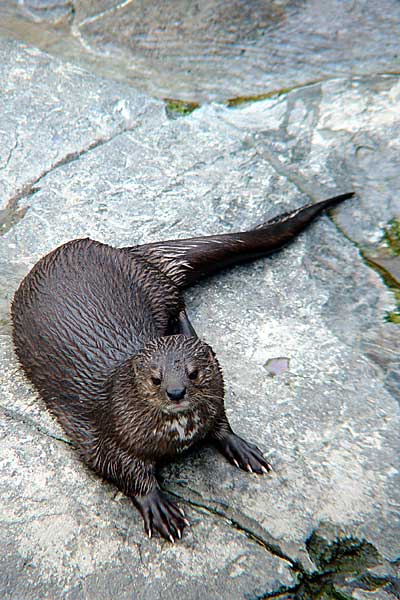 Spotted-Necked Otter. (Lutra maculicollis) The spotted-necked otter is found in southeast Asia, India, China, Pakistan, and Iraq. I couldn't find any more info about it. |
|
| Aug 1st, 2003 11:57 AM | ||
| agroskaterik | Oh!.. um.. sea otters kick ass! | |
| Aug 1st, 2003 11:35 AM | ||
| Jeanette X |
I'm guessing by the lack of any response that none of you like sea otters. Whats wrong with you people? :attentionwhore |
|
| Jul 30th, 2003 07:07 PM | ||
| Jeanette X |
Quote:
 Sea Otter (Enhydra lutris)  Sea otter pup. Sea otters are smallest marine mammal. They can dive up to 180 feet, and use rocks, shells, or manmade objects to pry food from rocks. They eat various mollusks, starfish, crustatians, abolone, and urchins. They will usually use rocks to smash open shelled animals, and this distinguishes them as tool users. The loose skin under their forelegs serves a pouch to hold food that has been gathered under water. They must eat 20-25% of their body weight in seafood each day to maintain their body heat, because unlike most other sea mammals, they have no insulating layer of blubber. They also maintain warmth with their thick fur, which they will usually spend about half the day grooming to maintain its insulating properties.When sleeping, they lie floating in the water, having wrapped themselves in kelp to keep from floating away. A group of otters resting together in this fashion is called a "raft". When the otter sleeps during the day, it covers its eyes with its paws to block out the sun.  The male sea otter has been known to grab the pups away from their mothers, only releasing them when the female otter presents him with food. Male sea otters mate with females by biting their noses and mounting them from behind. Some females have been known to drown while the male mates with them, although this is rare. The sea otter was once almost extinct due to years of hunting, but in 1911 protections were instituted and the sea otter has made a significant comeback. Sadly, many otters were killed in the 1989 Exxon-Valdez oil spill. Sea otters are one of the most vunerable species when it comes to oil spills, as the oil ruins the insulating qualties of their fur and causes them to die of hypothermia. 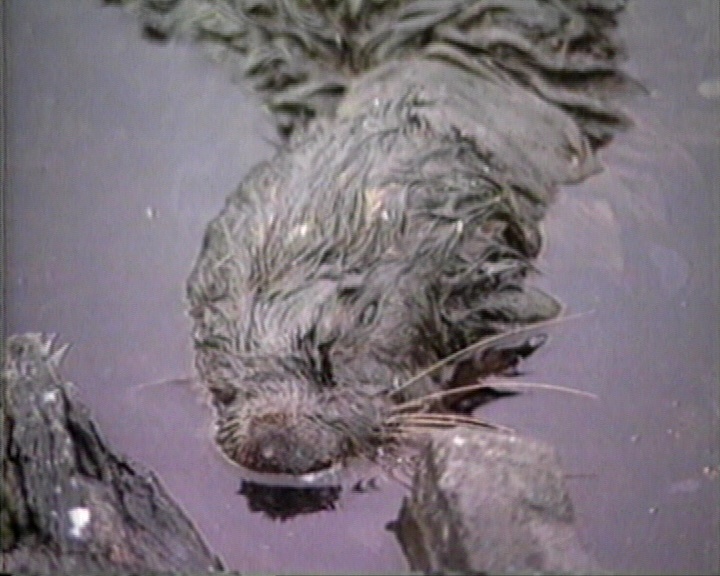 Dead sea otter.  Rescued sea otter being groomed after being cleaned of oil. Although the coast of Alaska seems to have recovered well from the spill, it will be a long time before it and the otter population have fully bounced back. Sea otters are considered a keystone species of the marine ecosystem, meaning that their presence or absence significant effects the ecosystem as a whole. Scientists believe that the sea otter contributes significantly to marine ecosystem of the sea, and protecting them is a high priority of environmentalists. |
|
| Jul 28th, 2003 03:08 PM | ||
| Big Papa Goat | This thread makes me happy. | |
| Jul 28th, 2003 12:02 PM | ||
| Jeanette X |
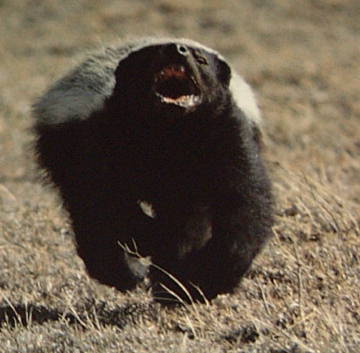 Ratel (Mellivora capensis) The Ratel is not a true badger, but it is often referred to as a "honey badger" because of its fondness for honey. It has a symbosis with a bird called the honeyguide. The honeyguide will lead the ratel to a bees nest, and the ratel answers its calls with howls until the nest is reached. Then, the ratel fumigates the hive with the skunk-like secretions from its anal glands, which causes most of the bees to fly away, and kills the rest in the hive. The ratel then eats the honeycomb. When it is finished, the honeyguide eats the leftover honeycomb, dead bees, and grubs. The ratel is a very dangerous animal. When threatened, it rushes to its attacker with an angry roar, and rips out the testicles. Next: Otters! |
|
| Jul 25th, 2003 01:08 PM | ||
| KILLADEUCE | I have nightmares of bieng chased by a hog badger... | |
| Jul 25th, 2003 01:03 PM | ||
| Jeanette X |
Ha ha! I'll be you fuckers thought I was done with this thread! Well I don't care if you've lost interest! I'm going to finish it, you hear me?! I'm not even done with the badgers yet, let alone the otters! MWAHAHAHAHA! Seriously, I promise you guys that the next time I do a family this large, I will break it up into multiple threads. Like ferrets? Like badgers? Well then you'll like the ferret badgers! Although they are classified as badgers and not ferrets, they look like combinations of the two.  Chinese Ferret Badger (Melogale moschata) Unlike other badgers, the ferret badgers do not dig their own holes, but use preexisting ones. The Chinese ferret badger has been observed sleeping in trees. I could not find any pictures of the other two species the Burmese ferret badger (Melogale personata), and Everett's ferret badger (Melogale everetti). There was also next to no information about them.  The Hog Badger (Arctonyx collaris) The hog badger is found in China and southeast Asia. They are ominivorous. It is known to fight predators quite fiercely when threatened, and when a spotlight is beamed on it at night, it will often dig itself out of sight. |
|
| Jul 16th, 2003 10:57 PM | ||
| Jeanette X |
 North American Badger (Taxidea taxus) 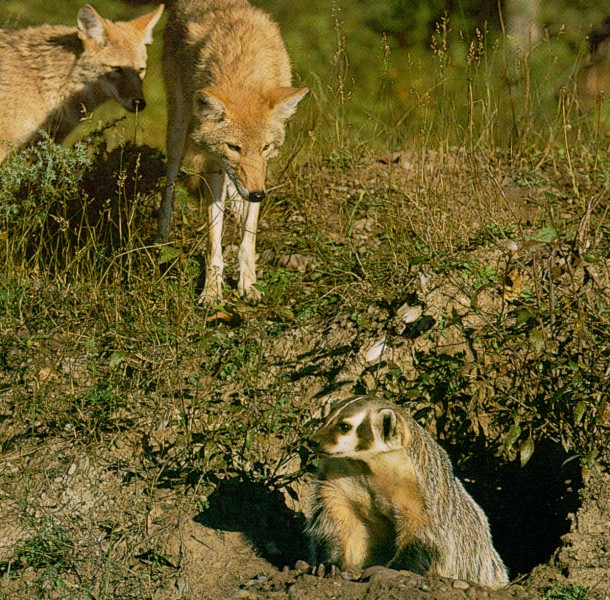 Badger with coyotes. 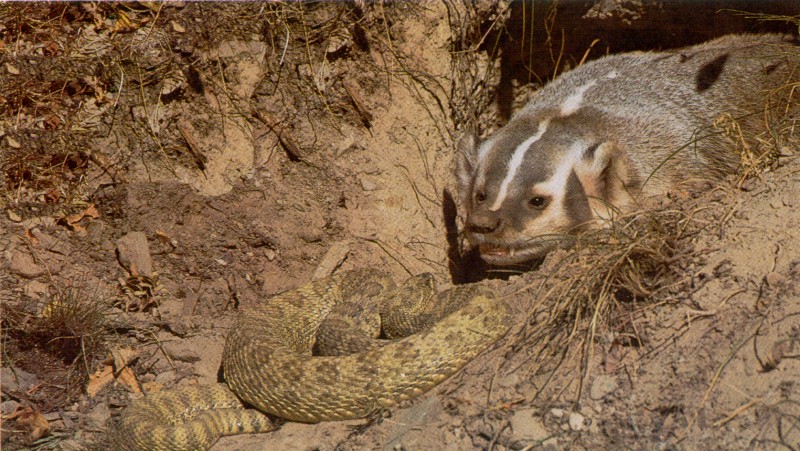 Badger vs. snake. The North American badger is much more fierce and solitary than it's European cousin. It is found primarily in the great plains region, although its range has expanded greatly since the start of the 20th century, and it is now found in Canada. They have few natural enemies other than man, and can easily outfight a dog. They can dig through very hard dirt, and there are even anecdotal accounts of badgers digging through pavement and concrete. Unlike the European badger, which is a forager, the American badger hunts its prey, eating mainly small rodents that it uncovers by digging. Coyotes have been known to stand around while badgers dig for their meals, grabbing whatever escapes the badgers grasp. This relationship appears to be a symbosis, although it is unclear what the badger gets out of it. Coyotes have even been observed attempting to initiate play with the badger, who is generally not interested. Occasionally coyotes prey upon young badgers, but their relationship is usually a mutually benifical one. North American Badgers also eat poisonous snakes. Their thick, loose skin is too difficult for the snake to pierce, and the badger is practically invincible against the snake unless it is bitten directly on the nose. |
|
| Jul 10th, 2003 12:30 PM | ||
| Jeanette X |
And now, for my favorite animal in the world:  The Eurasian Badger. (Meles Meles) Eurasian Badgers live in social groups of, on average, 6 adults (although groups as large as 23 have been recorded). Sociality was not recognized in this species until fairly recently, however, since badgers are only seen by humans when the animals are out alone at night to forage. More detailed study has revealed that they actually live together in large underground catacombs called "setts." These are systems of interlocking tunnels with nest chambers, toilets, and several entrances. Badgers inherit setts from their parents generation after generation, while always expanding and refining them. The result is huge tunnel systems that are, in some cases, actually centuries old. Excavation of a sett in England revealed that it contained 879 meters of tunnels, 50 chambers, and 178 entrances. The researchers estimated that its construction required the removal of 70 tons of soil! Genetic analysis has shown that members of badger social groups or "clans" are closely related. Through radiotracking it has been determined that this is due to delayed dispersal, resulting in family groups remaining together. Females are even less likely than their brothers to leave the sett in which they were born. Clans often consist of a dominant male, a dominant female, and their subordinate offspring. The dominant pair are generally the only individuals that successfully produce cubs, although all or most of the females mate with the dominant male. Subordinate females often become pregnant, but on the few occasions when the pregnancy is carried to term the dominant female generally finds and kills the resultant cubs. Subordinate badgers do not seem to be "helpers at the nest," as are found in some birds and a few mammals. Although it is difficult to observe badgers since they are only above ground at night, it seems clear that subordinates do not bring food to the nest for the breeding female or her cubs. They do, however, participate in sett excavation and the airing of nest material, but not at significantly higher rates after the birth of a litter. (Nest material is frequently carried to a sett entrance where it is aired in the sunshine for several hours, probably cutting down on external parasites.) Badger clans are territorial, defending an area (50 to 150 hectares) that contains their home sett and several foraging areas. They delineate their territories by placing latrines, areas where all clan members urinate and deficate, at regular intervals along the borders. Territories are also outlined by the paths that the badgers use when patrolling the boundaries. They mark both paths and latrines with the copious and decidedly odoriferous secretions of their subcaudal glands. Badgers, especially males, will aggressively defend their territories against intruding foreign badgers. The functions and patterns of sociality in this species are not well understood. It is possible that climate is an important factor. Average group size varies throughout their range, and in some areas, such as southern Europe, they seem to be solitary. Where badgers live singly or in pairs the climate tends to be warm, and their setts are small and simple. In colder areas the setts are dug down below the depth to which the ground freezes, and the whole clan sleeps together in one nest chamber, possibly for warmth. Thus large, cooperative groups may be necessary for the construction of deep setts and the sharing of body heat, although this hypothesis has not been thoroughly tested. Badgers remain fairly common in much of their range, probably because they are able to live among humans. It is not uncommon in England for the range of a group of badgers to include suburban developments, especially since some people intentionally leave food out for them. A matter of some concern is the preservation of historic badger setts. Since some of these constructions are centuries old, citizens have sometimes successfully argued for their preservation despite proposed real estate and infrastructure developments. |
|
| Jul 5th, 2003 02:59 PM | ||
| The_voice_of_reason |
Quote:
|
|
| Jul 5th, 2003 02:52 PM | ||
| Jeanette X |
Quote:
|
|
| Jul 5th, 2003 02:49 PM | ||
| Anonymous | shouldn't you be dead or something | |
| Jul 5th, 2003 02:48 PM | ||
| The_voice_of_reason |
Quote:
Zorilla is Spanish for skunk. |
|
| Jul 5th, 2003 02:04 PM | ||
| Jeanette X |
 Zorilla (Ictonyx striatus) I know what you're thinking: "What the fuck? Zorilla? That's a skunk!" Although it resembles a skunk, the zorilla (or striped polecat as it is also known) is actually not a skunk at all. Skunks, in fact, are no longer members of the mustelid family, having been reclassified into their own family, the mephitae, along with the stink badgers. (Those damn taxonomists keep shuffling species into different catagories and forget to tell me about it!) But the zorilla remains classified as a mustelid. They are found all over Africa. Before I move on to the otters and badgers, who are also mustelids, here are the ones I left out because I could find little to no information about them: Greater grisón (Galictis vittata) Little grisón (Galictis cuja) Patagonian weasel (Lyncodon patagonicus) North African Striped weasel (Poecilictis libyca) African Striped weasel (Poecilogale albinucha) |
|
| Jul 4th, 2003 06:06 PM | ||
| Jeanette X |
No it is NOT a ferret. It is in an entirely separate genus from both domestic ferret, and the black-footed ferret. Go back and look at the other posts to learn what ferrets really are.  |
|
| Jul 4th, 2003 05:42 PM | ||
| Matt Harty | ITS A FERRET! :D | |
| This thread has more than 25 replies. Click here to review the whole thread. | ||